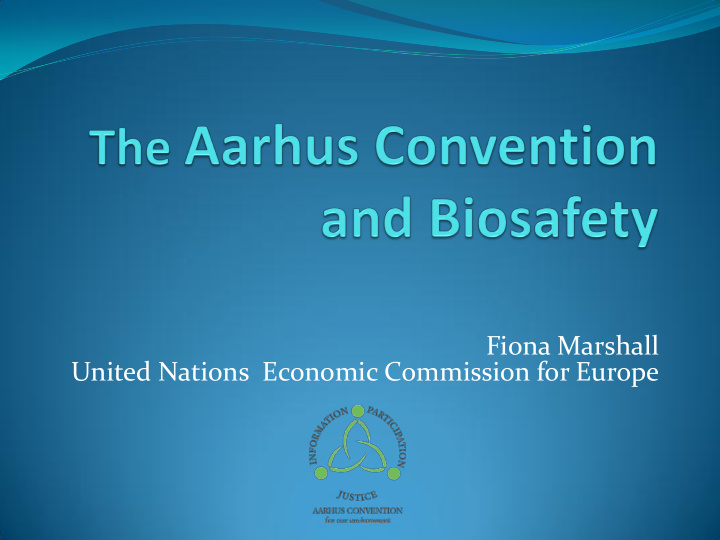



Fiona Marshall United Nations Economic Commission for Europe
What is the Aarhus Convention? How does the Aarhus Convention work? What is its relevance for biosafety? Future steps for Aarhus and biosafety
What is the Aarhus Convention? Convention on Access to Information, Public Participation in Decision- Making and Access to Justice in Environmental Matters Three pillars: information, participation, justice Entered force in 30 October 2001, now has 44 Parties: 43 countries and the European Union Parties adopted Lucca Guidelines on GMOs in 2002, still a useful tool Amendment on public participation in GMO decisions adopted in May 2005, not yet in force.
What is the Aarhus Convention? Most far-reaching international treaty on environment and human rights First international environmental treaty to allow members of the public to bring cases before the compliance mechanism Expressly covers information and decisions on GMOs Neither for or against GMOs Aarhus Clearinghouse, which also contains biosafety related materials.
How does the Aarhus Convention work? Requires Parties to provide access to information, public participation and access to justice to the public regarding the environment Obligations mainly fall on public authorities Rights are owed to the public, or the public concerned
The Aarhus Convention and biosafety Right of access to information Has two sides: active and passive: Public has right to environmental information upon request Obligation on Parties to collect and disseminate environmental information, including on GMOs Environmental information widely defined Includes (among other things) any information in any form on the state of elements of the environment, eg air, atmosphere, water, soil, land, landscape and natural sites, biological diversity, including genetically modified organisms, and the interaction between these elements.
Passive information obligation: Access to information on GMOs on request Requirements: Without interest having to be stated In form requested As soon as possible or at latest within one month Reasonable charges published beforehand Limited grounds for refusal to be interpreted in a restrictive way
Active information obligation: To collect and disseminate environmental information Parties must ensure that: Public authorities have up-to-date environmental information relevant to their functions Systems are established to ensure an adequate flow of information to public authorities about proposed and existing activities which may significantly affect the environment Also product information: Parties must develop mechanisms to ensure that sufficient product information is available for consumers to make informed environmental choices.
Public participation in GMO decisions – current article 6 (11) Currently, Parties must apply the Convention’s public participation requirements on decisions on whether to permit the deliberate release of GMOs into the environment to the extent feasible and appropriate within the framework of its national law
Public participation in GMO decisions – current article 6 (11) Requirements: Reasonable timeframes Early public participation when all options are open Applicants encouraged to identify public concerned, to provide information and to enter into discussions with them before applying for a permit All relevant information to be accessible to public concerned upon request, free of charge
Public participation in GMO decisions – current article 6 (11) Requirements (continued): Opportunity for public concerned to comment Due account of public participation Public to be promptly informed of decision and decision (including reasons) to be made accessible
Aarhus Convention amendment on GMOs, 2005 In 2005, Parties to the Aarhus Convention adopted an amendment to the Convention on public participation in GMO decisions Requires Parties to provide for early and effective information and public participation in decisions on the deliberate release into the environment and placing on the market of GMOs Will enter into force when ratified by ¾ of Parties at time amendment was adopted. Has 26 ratifications, 22 of which count to entry into force, needs 5 more.
Requirements: Gives rights to “public”, generally, not just “public concerned” Requires a reasonable timeframe in order to give the public an adequate opportunity to express an opinion on proposed decisions Some possible exceptions For deliberate release, if another such release in comparable bio‐geographical conditions approved by Party and sufficient experience gained For placing on market, if already approved by Party or if intended for research or future culture collection
Summary of notification to obtain authorization and assessment report to be made public in timely and effective manner, if available Some information cannot be kept confidential: General description of GMO, name and address of applicant, intended use, and if appropriate, location of release Methods and plans for monitoring and emergency response Environmental risk assessment
Must ensure transparency of decision‐making procedures Public entitled to submit any comments, information, analyses or opinion it considers relevant Must endeavour to take due account of outcome of public participation Text of decision, along with reasons, to be made public
Access to justice regarding GMOs For a refused request for information For impairment of a right provided under the national law regarding public participation in decisions on deliberate release covered by art 6(11) – but not regarding decisions covered by GMO amendment. To challenge an act or omission by private persons or public authorities which contravenes national environmental law
Lucca Guidelines on GMOs, 2002 Non‐binding examples of good practice Most far‐reaching and detailed instrument on GMOs e.g. covers contained use as well as deliberate release and placing on the market Still a valuable guidance tool
Future steps for Aarhus and biosafety Entry into force of the GMO amendment Preparation of draft 2012-2104 work plan More effective implementation of Convention’s provisions Collaboration and dialogue with Cartagena Protocol and other relevant organizations
Thank you! Fiona Marshall Aarhus Convention secretariat, UNECE fiona.marshall@unece.org www.unece.org/env/pp
Recommend
More recommend